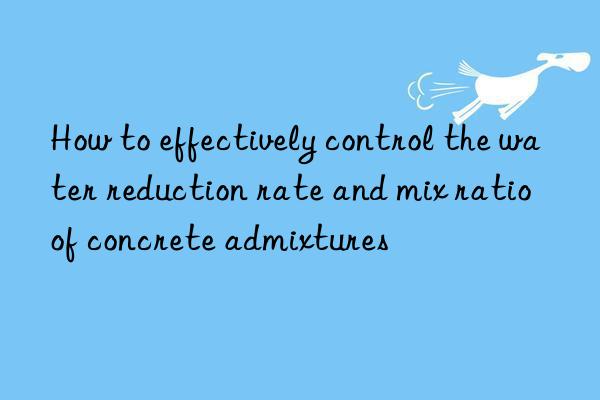
You can refer to GB8076, which has detailed mix ratios, experimental methods, and evaluation standards, which can help you very well.
Mix ratio
The benchmark concrete mix ratio is designed according to JGJ55. The proportions of cement, sand and stone in the tested concrete mixed with non-air-entraining admixtures are the same as those in the corresponding benchmark concrete. The mix ratio design should comply with the following regulations:
a) Cement dosage: The unit cement dosage of the benchmark concrete and the tested concrete mixed with high-performance water reducing agent or pumping agent is 360kg/m3; other admixtures are mixed The unit cement dosage of the benchmark concrete and tested concrete is 330kg/m3.
b) Sand rate: The sand rate of the benchmark concrete mixed with high-performance water reducing agent or pumping agent and the tested concrete are both 43% to 47%; the sand rate of the benchmark concrete mixed with other admixtures and the tested concrete The sand rate of concrete is 36% to 40%; however, the sand rate of the tested concrete mixed with air-entraining water-reducing agent or air-entraining agent should be 1% to 3% lower than the sand rate of the benchmark concrete.
c) Additive dosage: According to the dosage specified by the manufacturer.
d) Water consumption: The slump of the reference concrete and the tested concrete mixed with high-performance water-reducing agent or pumping agent is controlled at (210±10) mm, and the water consumption is when the slump is ( The minimum water consumption is 210±10) mm; the slump of the reference concrete mixed with other admixtures and the tested concrete is controlled at (80±10) mm. Water consumption includes the amount of water contained in liquid admixtures, sand, and stone materials.
Water reduction rate determination
When the water reduction rate is basically the same as the slump, the difference between the unit water consumption of the benchmark concrete and the tested concrete is the ratio of the unit water consumption of the benchmark concrete. The water reduction rate is calculated according to formula (2) and should be accurate to 0.1%.
WR = (W0 - W1)/W0×100……………………(2)
Where:
WR— ——Water reduction rate, %;
W0——Unit water consumption of benchmark concrete, unit is kilogram per cubic meter (kg/m3);
W1——Inspected The unit water consumption of concrete is expressed in kilograms per cubic meter (kg/m3).
H R is calculated as the arithmetic mean of three batches of tests, accurate to 1%. If the difference between the maximum or minimum value of the three batches of tests and the middle value exceeds 15% of the middle value, the maximum value and the minimum value are discarded together, and the middle value is taken as the water reduction rate of the group of tests. If the difference between two measured values and the middle value exceeds 15%, the test results of this batch are invalid and should be repeated.
For detailed suggestions, take a look at the national standard 8076. I hope it can help you.
</p

 微信扫一扫打赏
微信扫一扫打赏

